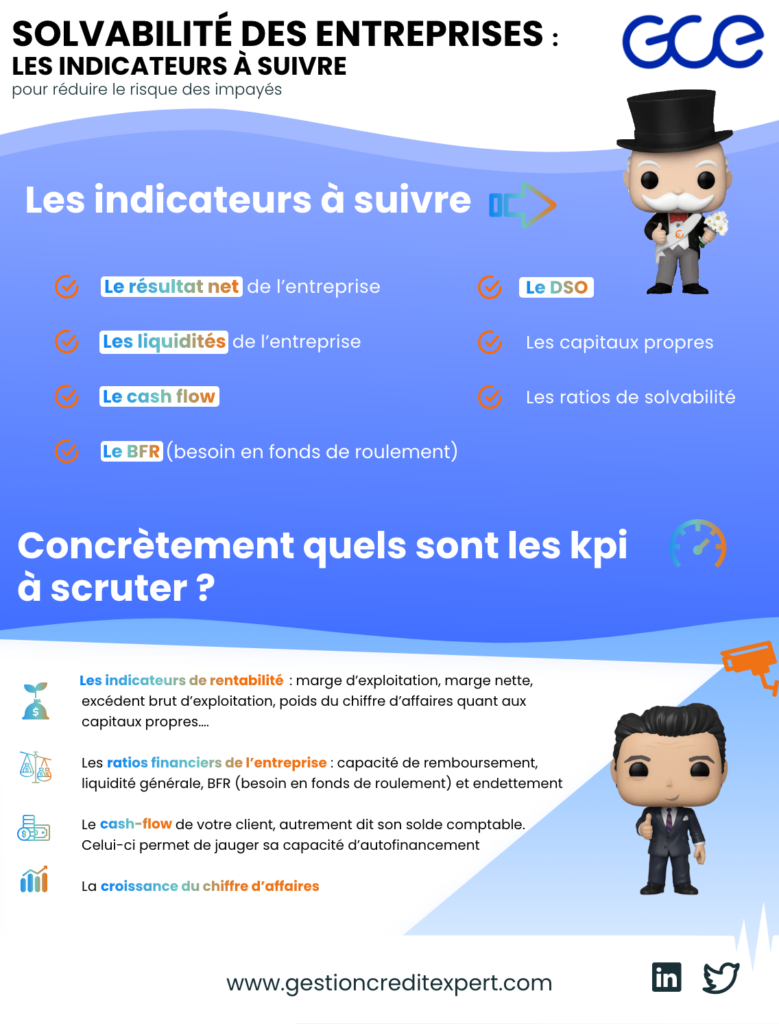Solvency indicators to follow to reduce the risk of non-payment
In order to avoid any risk of non-payment, it is more than recommended to study the solvency of your business partners.

To do this, it is possible to engage external service providers for commercial information on the ground. Their goal is to provide a complete financial report and a clear and accurate assessment of credit risk. You can alsoestimate the creditworthiness of the company yourself by having the necessary financial information.
What is corporate creditworthiness?
The solvency of a company refers to its ability to meet its financial obligations in the short, medium and long term. Note that the concept of solvency is different from that of liquidity.
Liquidity refers to the ability to meet payment obligations that have fallen due. In this sense, it is an immediate or short-term solvency.
Thus, even if a company is qualified as solvent, it may also be lacking in liquidity (bank account, cash) or quasi-liquidity (assets that can be quickly transformed into cash).
In the opposite case, it is also possible: an immediate liquidity can hide a medium or long term insolvency (long term supplier debts, taxes…).
Before entering into a business relationship, it is recommended that you conduct a credit check. It allows us to analyze the economic, financial and legal situation of your client. To do this, several sources are available such as the :
- Official records
- Banks
- Files of the Banque de France
- Specialized rating agencies
- Private companies specializing in credit studies
- Customers and their sales representatives
How to perform a credit analysis of a company?
There are several metrics that can be used to measure the creditworthiness of a company. They refer to the financial analysis:
- Assets – Debts: the client is solvent if the result of this subtraction is positive
- Total debt / Total balance sheet: if this ratio is higher than one, the company is in bankruptcy or in serious difficulty
- Net debt / gross operating surplus: this ratio is used to estimate the capacity of a company to pay and repay its debts
- Gross operating surplus / Loan and lease annuity: this rate is very much in demand by credit institutions. The higher it is, the more room the company has to increase its debts and borrow.
These ratios are calculated from the elements of the company’s balance sheet. While all companies are still required to send their social accounts to the Registry of the Court, confidentiality has been made possible since the Macron law of 2015 for micro-enterprises, VSEs and small businesses under certain conditions. For these it is always possible to order field sales information.
Upstream, other financial ratios exist to measure financial risk. This is also the case for the sources of information available to refine the creditworthiness study: commercial information, legal information, internal information (accounting and customer receivables management charts).
Finally, the financial, commercial and legal information obtained is used to establish the credit report and the company scoring.
How to analyze a client’s performance indicators?
In order to conduct a credit assessment of your customer or prospect, you can use several performance indicators, including
- Profitability indicators: operating margin, net margin, gross operating surplus, ratio of sales to equity….
- The company’s financial ratios: repayment capacity, general liquidity, WCR (working capital requirement ) and debt
- Your client’s cash flow, i.e. its book balance. This allows you to gauge your self-financing capacity
- Or revenue growth
This data is important because it gives you an accurate picture of your client’s cash flow. They also allow you to know your capacity to pay your debts within the imposed deadlines.
9 Solvency indicators to monitor
To have a global vision of a company’s performance, you can use indicators related to human resources, marketing, and even accounting and financial dimensions. These general indicators will be amplified by indicators more specific to your activity.
1) The company’s net income
This takes into account the amount of money earned by a company. Net income includes operating income, financial income and extraordinary income. To these, taxes must be deducted.
If the net result is positive, a company is able to distribute dividends to its shareholders or make reserves. On the other hand, if the result is negative, the company loses its value.
2) The company’s liquidity
This is an essential notion in terms of business management. Cash refers to the total amount of money available for immediate use. This is the money that the company has at its disposal: coins, bills, bank and financial assets. This indicator allows you to evaluate your capacity to honor your short-term debts.
3) Cash flow
Cash flow is the flow of liquidity of a company:
- If it is positive, the company has liquidity
- If it is negative, the company is in difficulty and you must automatically bring in money or reduce your expenses
4) Working capital requirements (WCR)
The WCR corresponds to the amounts that a company needs to cover the gaps in its cash flow, i.e. between its disbursements and its receipts.
The longer your customers take to pay you, the more your WCR increases, hence the urgency to collect your receivables quickly.
5) DSO
Days Sales Outstanding or DSO is related to the number of days of sales invoiced but not yet collected.
This indicator is useful for defining the company’s working capital requirements.
6) Equity
It is a fundamental component of a balance sheet. Equity allows us to assess the value of a company: definition, method of calculation and usefulness.
7) Solvency ratios
There are several ratios that come into play when assessing the creditworthiness of a company. These are mainly the ratios:
- Financial autonomy to evaluate the indebtedness
- Financial independence being essential to analyze the financial balance of the company
- General liquidity used to evaluate the ability of a company to pay its short-term debts
- Repayment capacity, which measures the weight of annual debt repayments on the company’s internal resources

8) Shareholders’ equity
It is a fundamental component of a balance sheet. Equity allows us to assess the value of a company: definition, method of calculation and usefulness.
9) Solvency ratios
There are several ratios that come into play when assessing the creditworthiness of a company. These are mainly the ratios:
- Financial autonomy to evaluate the indebtedness
- Financial independence being essential to analyze the financial balance of the company
- General liquidity used to evaluate the ability of a company to pay its short-term debts
- Repayment capacity, which measures the weight of annual debt repayments on the company’s internal resources
How do you choose which indicators to monitor?
In order to be effective and relevant, a performance indicator must meet certain criteria. It must therefore:
- Be specific, clear and simple to understand
- To measure the achievement of an objective in comparison with the standard set beforehand
- Avoid being overly ambitious, allowing for achievable goals
- Be time-bound
Corporate solvency: what is a solvency report?
A company’s credit report provides a mapping of its credit history. It aims to reduce credit risk by identifying the warning signs of payment incidents such as late payment or non-payment.
The financial report, or credit report, consists of the following:
- Legal information of the company
- Collective proceedings
- Payment habits
- Sanctions DGCCRF
- Credit score determined by financial experts
6 Tips to prevent the risk of non-payment
Unpaid invoices, like late payments, are detrimental to the health of your cash flow, but also to the continued operation of your business. So how do we prevent them?
1) Carry out customer risk analysis to reduce non-payment
Before committing yourself to a prospect, it is your duty to make sure that he or she is creditworthy. Official websites provide access to essential company documents (balance sheet, management report or income statement).
2) Negotiate down payments
Negotiating down payments of at least 30% on orders with your customers is another avenue to explore to minimize unpaid invoices. This ensures that the client has sufficient liquidity to meet the first payment.
3) Use direct debit
The SEPA direct debit is a dematerialized payment method. It allows the creditor to trigger the payment of an invoice, denominated in euros, when it has reached its term. In this way, you can reduce unpaid bills and optimize your cash flow. In fact, it is not the debtor who initiates the payment, but you.
4) Implementing a cash culture in the company
Coming from the Anglo-Saxon business world, the cash culture, or financial culture, is gradually spreading in France. It tends to associate all the company’s employees towards a common objective: optimizing cash flow, the engine of economic activity.
5) Send a reminder before the due date
In some cases, late payment is caused by an oversight on the part of the debtor. It is therefore essential to keep an eye on invoice payment deadlines and to notify your customers when they are due. You can use software that generates automatic reminders before the due date.
6) Outsource debt collection
If you realize that a bill has not been paid, it is important to take care of it as soon as possible! And for good reason, your chances of collecting an unpaid bill are diminishing day by day. If you are in this situation, it is possible to call upon a debt collection company .
